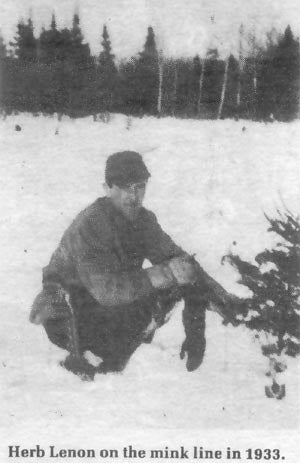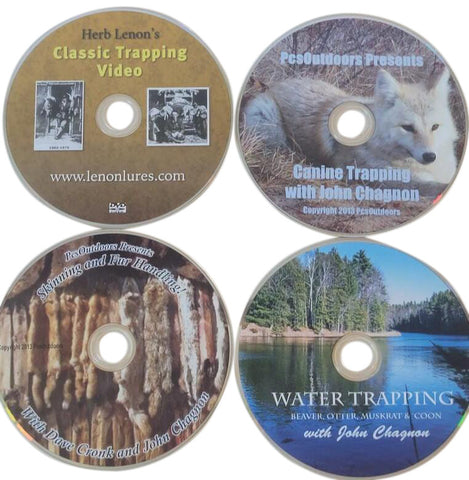Mink Trapping by Herb Lenon Article 1946
FIRST PUPLISHED THE TRAPPERS WORLD MARCH 1946
Mink Trapping
By HERBERT LENON

Trapping the cunning and valuable little mink, while not nearly so fascinating as trapping wolf, coyote or fox, is very interesting and where they are found in any considerable numbers is very profitable at present market prices.
Many trappers fail to become successful mink trappers, just as a greater number try for many years, without success, to trap the so called “sly Renard”.
In this game of trapping, the first requisite is normal intelligence, second, ambition, third, thoroughness, fourth, the ability to criticize one’s self and fifth, a knowledge of the habits and habitat of the animal one expects to trap.
One of the primary factors to consider in trapping wolf, coyote or fox, is their habitat of establishing scent posts, in trapping cat the curiosity factor is considered, but neither of those habits are of any real value in trapping mink.
Trapping Books Written By Herbert Lenon FREE online versions.
- Secrets of Successful Trapping Fox, Coyote, Bobcat Trapping by Herb Lenon
- Beaver and Otter Trapping Book Online by Herbert Lenon
- Mink and Muskrat Trapping Book Online by Herbert Lenon
- Raccoon, Opossum, Skunk and Weasel Trapping Book Online by Herb Lenon
The habits of the male and female mink very greatly, the female usually has a den under some log, jam, beaver dam or what not and quite early in the season settles there and seldom ventures far from it; therefore a trap set just anywhere along a likely stream may be too far from this den to be reached by the short forays of the female.
The male mink is quite a rambler, especially later in the season, but it is seldom they ramble many miles from some given area.
I believe the primary factor to consider in trapping mink is their seemingly constant search for food therefore I will write principally of this factor in the theory of mink trapping.
First then, what is the principal food source of mink; we will for purpose of instructing, say frogs, crayfish, minnows, and muskrat are the primary foods, leaving mice, rabbits etc., for the fox and coyote.
Next we will consider the places where those food elements are found or rather searched for, by the mink and naturally, traps would be set in such places.
Frogs and crayfish, with the coming of cold weather, will retire to springs and small warm streams where the possibility of the water freezing is less likely, I one time found nearly a bushel of frogs in one small spring, so naturally the place the mink will investigate is such small streams or springs.
The most productive set I have ever used for mink, is the underground stream set, this stream may be from a spring or from some body of water, back from the creek or river, that over a period of years has formed an outlet underground to the larger stream. These underground streams are the ideal place for frogs or crayfish to winter and usually one can find several on one’s trapline.
One year I trapped the Waska river in Chippewa county, this stream was of clay banks and rather difficult to trap, however I found one underground stream, a drainage from a body of water quite a distance back from the river, the outlet was about 2 feet above and 6 feet back from the fall water level of the river, the outlet was about one foot in diameter with 3 inches of water in it, the ideal place, minnows, frogs and crayfish were present in it.
Naturally I set a trap there and after the snow came, never even one mink passes without making its final investigation and last trip, to the funhouses.
When I was a small boy, I found such a place and over a period of years took scores of mink from it.
This place was on the same principle but formed from a different cause; it was a drain between two small streams.
These streams joined about 30 feet from my productive set, a large tree had fallen across both streams about 30 feet from the junction and over a period of many years the slower of the streams had become clogged each fall with drifting leaves etc., partly damming it, eventually it had formed a drain to the faster stream under this log, forming a hole about 6 or 8 inches in diameter, this drain seldom froze, even in the dead of winter if flowed with sufficient volume to keep an open place a foot or more in diameter, never a mink that passes it without checking for a delicious frog, minnow or crayfish, naturally Mr. Mink usually found one of my No. 1 ½ traps Newhouse double jawed trap I ever owned, for that particular place.
Second on my list of successful sets are such small streams where they enter larger streams, altho not underground.
Such streams, usually warmed by contact with peat or humus, seldom freeze until late in the season and are often alive with minnows, frogs, and crayfish, seldom will a normal mink pass by one without at least a preliminary investigation.
Where one finds such a stream, less than 8 inches in width, a trap placed in it just where it enters the larger stream, and another back about 4 feet from the first, will do the job, but where the stream is wider, say up to two feet in width, one should stake off with twigs or brush leaving a narrow opening for the trap, if the stream is say 3 feet in width and mink are at all plentiful, it may be a good policy to stake it off leaving two openings and setting a trap in each and possibly another back several yards from the stream where the small creek becomes narrow.
When trapping, I somehow attained the habit of what I called “manufacturing sets,” this method I adopted because of the fact that I could manufacture my ideal set in the area most frequented by mink while natural sets were often in areas where mink were plenty absent.
One of my manufactured sets was made thus: Where I found a small stream entering a larger stream, I would find a hollow log, if possible, if not I would take 2 flat slabs of wood for the sides another for the roof, place them in the stream, back about 2 feet from the larger stream, reinforce with rocks or other pieces of wood and cover with sod, sand, rock or whatever was available, thus forming a tunnel similar to an underground stream outlet, it sure worked and by forcing the water through a narrower opening, it did not freeze until long after it would have, if left as it was.
Another set I so often used was similar in principal but was made thus: Where I found an old deserted beaver dam, I would take a pole about 4 inches in diameter and ram a hole through the beaver dam at the water level, forming this hole so it was about 6 to 8 inches in diameter and with 3 inches of water running through it, this would remain open through it, this would remain open after the balance of the dam was frozen over, seldom a mink that failed to start through this hole.
Old rotten logs laying across small streams, partly damming the stream were good bets, I would cut and tip back the moss, usually covering them, then cut a notch in the log, in the middle of the stream, this notch 6 inches wide and deep enough for 3 to 4 inches of water to run through the moss was then tipped back over the fresh cut and trap set in it, the water rushed through the notch and usually there was open water in the notch and a foot or two above and below it after the rest of the stream was frozen.
I also used quite extensively, the followed double set, this set was made with a trap on each side of a stream and was made thus: At a bend in the stream one usually finds a sloping bank on one side, usually with a sandy shore, while on the other shore is a steep bank.
During high fast running water, the soil is often washed out under the steep bank, but on the brink, due to the holding action of grass and plant roots, there will be an eaves, hang down from the bank forming a tunnel, quite often above the normal level.
Mink seem to like there tunnels, probably because they can travel them peeking down into the stream without being seen by minnows or other potential food life, a set in each end of the tunnel, with a little fresh bait or good lure between them, will produce their share of pelts.
Directly across from this tunnel, as I previously mentioned, is usually a sloping sore, here I would set a trap, in the edge of the stream, where the water is about 3 inches deep, out into the stream from the trap I plant guide twigs about 2 inches apart, thus forming a fence or barrier about 30 inches long with only the one opening where the trap is set, the simple, this set produces very satisfactory.
However, as I first said, normal intelligence and an understanding of the habits and habitat of any animal we wishes to trap is of prime importance and with the mink the major factor to be considered, is their constant snooping through every hole, spring, small stream, jam pile, tunnel, etc., in search of food.
Lenon's Mink Lure
Mink Nature's Call Lure - Mink Super All Call Lure - Mink Super Range All Call Lure - Mink Urine
Trapping Books Written By Herbert Lenon FREE online versions.
- Secrets of Successful Trapping Fox, Coyote, Bobcat Trapping by Herb Lenon
- Beaver and Otter Trapping Book Online by Herbert Lenon
- Mink and Muskrat Trapping Book Online by Herbert Lenon
- Raccoon, Opossum, Skunk and Weasel Trapping Book Online by Herb Lenon
Lenon Lures Online Product Catalog
Thank You Trappers for making us your top choice for the last 100 Years! Lenon Lures Established 1924
Trappers check out our Dvd's Video on Trapping Furbearing Animals Herbert Lenon's Trapping video
Herbert Lenon and John Chagnon Trapping and Fur Handling Videos Dvd's
Herbert Lenon and John Chagnon Trapping and Fur Handling Videos Dvd's
Ebay carries all of Lenon Lures® products and is a great place to find deals on all kinds of used and new traps & equipment for coyote, fox, bobcat and wolf trapping at great prices.
Follow the links below to some more great trapping information on Lenon Lures website ...
- Secrets of Successful Trapping Fox, Coyote, Bobcat Trapping by Herb Lenon
- Beaver and Otter Trapping Book Online by Herbert Lenon
- Mink and Muskrat Trapping Book Online by Herbert Lenon
- Raccoon, Opossum, Skunk and Weasel Trapping Book Online by Herb Lenon
- Herb Lenon Trapper's Hall of Fame Article
- Herb Lenon 1947 Full Page Ad in Fur Fish Game Magazine
- How To Trap Fox & Coyote - Herb Lenon and Asa Lenon
- Mink Trapping by Herb Lenon Article 1946
- Trapper's Bible of Trapline Secrets, Sets and Knowledge by Herb Lenon
- Monthly Tips on How To Trap by John Chagnon & historical writings Herb and Asa Lenon of Lenon Lures


